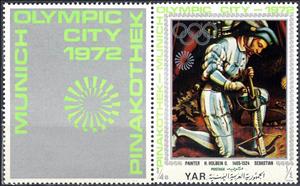Stamp with Attached Label: H. Holbein t.e.: The Martyrdom of Saint Sebastian (Yemen, Arab Republic 1971)
H. Holbein t.e.: The Martyrdom of Saint Sebastian (Yemen, Arab Republic 1971)
15 March (Yemen, Arab Republic ) within release Olympic City Munich: Paintings from the Old Pinakothek goes into circulation Stamp with Attached Label H. Holbein t.e.: The Martyrdom of Saint Sebastian face value ¼ Yemeni buqsha
| Stamp with Attached Label H. Holbein t.e.: The Martyrdom of Saint Sebastian in catalogues | |
|---|---|
| Colnect codes: | Col: YE-AR 1791.03.15-01 |
Stamp with Attached Label is square format.
Also in the issue Olympic City Munich: Paintings from the Old Pinakothek:
- Stamp - Count Palatine Otto of Wittelsbach receives a Greek embassy face value 4;
- Souvenir Sheet - A. Altdorfer: Susanna in the bath face value 4;
- Stamp with Attached Label - H. Holbein t.e.: The Martyrdom of Saint Sebastian face value ¼;
- Stamp - A. Altdorfer: Susanna in the bath face value 2;
- Stamp - A. Altdorfer: Susanna in the bath face value 4;
- Stamp - A. Dürer: O. Krel face value 1½;
- Stamp - A. Dürer: Young man face value ¾;
- Stamp - H. Holbein t.e.: The Martyrdom of Saint Sebastian face value ¼;
- Stamp - H.B. Grien: Count Philipp face value ⅓;
- Mini Sheet - Olympic City Munich: Paintings from the Old Pinakothek face value 15;
- Stamp - W. Leibl: C. Schuch face value 7;
Stamp with Attached Label H. Holbein t.e.: The Martyrdom of Saint Sebastian it reflects the thematic directions:
The modern Olympic Games or Olympics (French: Jeux olympiques) are leading international sporting events featuring summer and winter sports competitions in which thousands of athletes from around the world participate in a variety of competitions. The Olympic Games are considered the world's foremost sports competition with more than 200 nations participating. The Olympic Games are held every four years, with the Summer and Winter Games alternating by occurring every four years but two years apart.
Painting is the practice of applying paint, pigment, color or other medium to a solid surface (support base). The medium is commonly applied to the base with a brush, but other implements, such as knives, sponges, and airbrushes, can be used. Painting is a mode of creative expression, and the forms are numerous. Drawing, gesture (as in gestural painting), composition, narration (as in narrative art), or abstraction (as in abstract art), among other aesthetic modes, may serve to manifest the expressive and conceptual intention of the practitioner. Paintings can be naturalistic and representational (as in a still life or landscape painting), photographic, abstract, narrative, symbolistic (as in Symbolist art), emotive (as in Expressionism), or political in nature (as in Artivism). A portion of the history of painting in both Eastern and Western art is dominated by spiritual motifs and ideas. Examples of this kind of painting range from artwork depicting mythological figures on pottery, to Biblical scenes rendered on the interior walls and ceiling of the Sistine Chapel, to scenes from the life of Buddha or other images of Eastern religious origin. In art, the term painting describes both the act and the result of the action. The support for paintings includes such surfaces as walls, paper, canvas, wood, glass, lacquer, clay, leaf, copper and concrete, and the painting may incorporate multiple other materials including sand, clay, paper, plaster, gold leaf, as well as objects. The term painting is also used outside of art as a common trade among craftsmen and builders.
Sport is a form of physical activity or game. Often competitive and organized, sports use, maintain, or improve physical ability and skills. They also provide enjoyment to participants and, in some cases, entertainment to spectators. Many sports exist, with different participant numbers, some are done by a single person with others being done by hundreds. Most sports take place either in teams or competing as individuals. Some sports allow a "tie" or "draw", in which there is no single winner; others provide tie-breaking methods to ensure one winner. A number of contests may be arranged in a tournament format, producing a champion. Many sports leagues make an annual champion by arranging games in a regular sports season, followed in some cases by playoffs.



